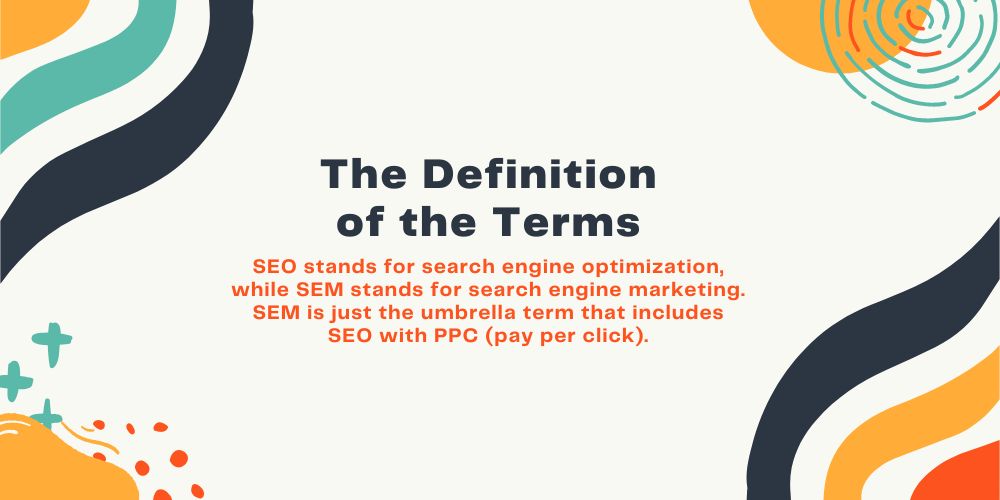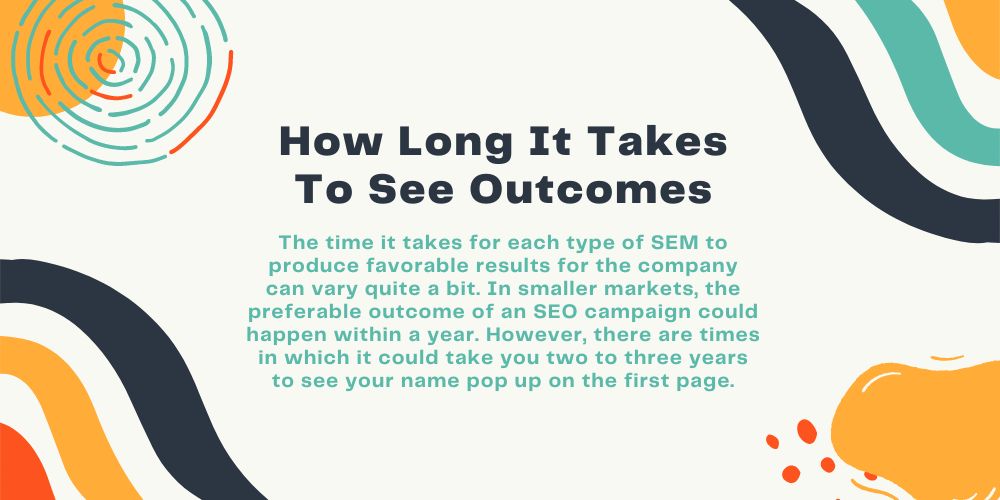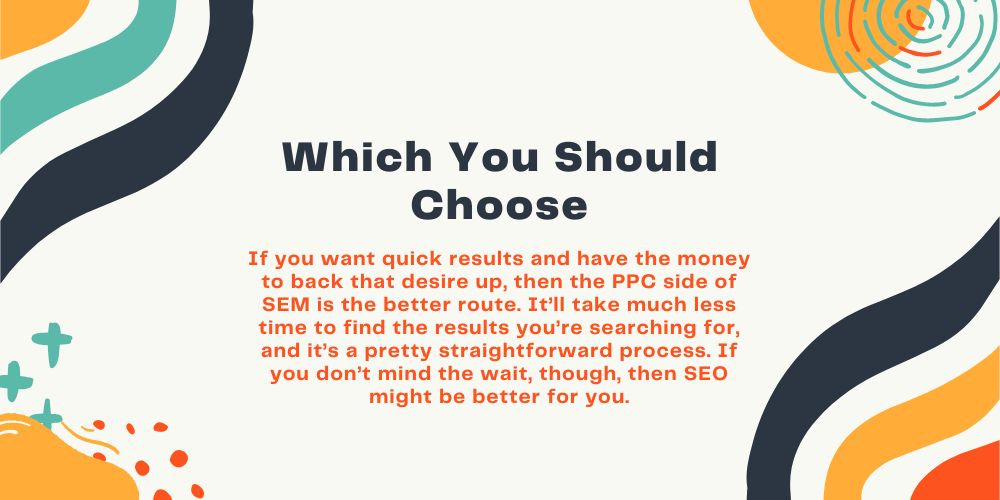SEO vs. SEM: What’s the Difference (and How To Choose)?
People regularly confuse the terms SEO and SEM. We’re here today to straighten them out and let you in on which one is the best option for your business.
There are so many ways to advertise your brand and products in online marketing that it can be difficult to track them all. That’s why it’s not uncommon to run into the issue of mixing up the terms SEO and SEM. Both of them deal with search engines, but they aren’t the same.
In this blog post, we’ll go over what differentiates SEO from SEM and what you need to know to choose between them. Hopefully, this will help reduce the overall level of confusion between these terms.

The Definition of the Terms
Let’s start by defining what each term means. SEO stands for search engine optimization, while SEM stands for search engine marketing. While this might make it seem like these two concepts are two separate parts of how companies use search engines, that’s not the case. SEM is just the umbrella term that includes SEO with PPC (pay per click).
This should now shed some light on what the two competing terms here are in truth. PPC is the true counterpart to SEO. Because SEM has a similar acronym, there’s lots of confusion between the two. That means that most of this post will actually be going over the differences between SEO and PPC since half of SEM is just the optimization side of things.
How They Differ
So how do these two marketing terms differ, apart from their names and definitions? Well, the number of differentiations between them is quite large, so we’re going to take the time to go in-depth on them here.
How They Work
There are many sides to SEO. Most of it deals with the on-page elements that people see, such as keywords, titles, and descriptions. However, there are just as many things going on behind the scenes. One such aspect is off-page SEO. This involves the backlinks that lead to your site. Whether they come from your social media pages or another company’s website, a larger number of external sources linking to your site will generally improve your SEO.
There’s a technical side to it too. If your website has broken links, slow-loading pages, or a confusing layout, these things could significantly hurt your SEO efforts. The bottom line is that if people leave your site quickly, search engines won’t want to promote them. The trick to SEO is finding a balance and making it work.
On the other hand, PPC is a bit more of a brute force approach. If you can throw enough money at these search engines’ bidding systems, you’ll be able to find success. However, there’s more that goes into PPC than money. You still need to have engaging copy that gets people to click. Since these search engines only make money off clicks, they prefer ads that can reliably attain them.
Just like SEO, though, you have to keep people on your site once they’re there. All the previously mentioned problems can lead to people leaving quickly after getting on, which will lower your Quality Score. The lower this score gets, the less likely your ad will be to be the one that wins the bidding process.
Of course, you can’t forget the keywords for PPC either. If your ads are showing up in results that aren’t relevant, they won’t have a high click-through rate, which will hurt your chances of your ad continuing to show up.
Where the Results Appear
Before putting too much time and money into one choice or another, it’s crucial to know where your results will appear on the search engines. For PPC, it’s simple. These results will always be at the top of the page. Ads used to appear on the right side of sites like Google, but they never performed well over there. These days, they appear as the first few results, leading to more consistent click-through rates.
SEO results are all the other results. The goal is always to be as close to the top of the first page as possible. That’s because people rarely go to page two of the search results looking for an answer. This problem is so widespread that it’s been a common joke online for many years. If your SEO efforts land you on page two, you basically don’t exist.
This is what makes SEO so challenging. Competition for the first page is brutal, depending on what you’re trying to sell. To make matters worse, the first page sometimes isn’t good enough. Most users only ever click the first link or two. If the top result gets a snippet that answers the person’s question, the chance of lower options getting any attention decreases significantly. This is why fighting for the top spot is so vital. As a result, some people opt to pay for it through PPC.

How Long It Takes To See Outcomes
The time it takes for each type of SEM to produce favorable results for the company can vary quite a bit. In smaller markets, the preferable outcome of an SEO campaign could happen within a year. However, there are times in which it could take you two to three years to see your name pop up on the first page.
Some companies don’t have that long to wait, which is why PPC is so popular. With the right keywords and enough cash to back the campaign, your company can nab the top result on Google within a few days.
The key thing to note here, though, is that the spot will not be permanent. You must keep optimizing your keywords and pages while continuing to throw money at them. While SEO could take a while, once you get to the first page, you’ll be able to hold on to that spot for a while. Obviously, you’ll still need to continually optimize in order to stay on top, but it will take much less effort to do so.
The Cost of Each
Of course, that brings us to the overall cost of each option. It should come as no surprise that PPC is the more expensive route. You have to bid how much you’ll pay when someone clicks on your link, which can get pricey if many other companies regularly compete for the same keyword. Fortunately, the system is automatic, and you can put a limit on how much you want to spend. However, that doesn’t change the fact that it’ll certainly cost you a lot out of pocket to follow this route.
On the other hand, SEO is free, but only technically. While you’re not paying the search engines directly to display your site, you are paying for the hours that go into developing an SEO campaign and then implementing it. SEO takes up a lot more time; you’ll need to hire a team that can constantly work on it for you. If that’s not possible, you could outsource the work to another company, but that’ll cost you too.
In the end, even though SEO is free, it really isn’t. Even if you manage to run the entire campaign on your own, you’re still spending time optimizing your site that you could spend elsewhere. There’s always a cost. The only question is figuring out how you’d like to pay it.

Which You Should Choose
Even though our guide covering the differences between SEO and SEM focuses more on PPC than SEM, we hope this has helped straighten out the two terms for you. However, we still need to talk about how to choose which is best for your company.
If you want quick results and have the money to back that desire up, then the PPC side of SEM is the better route. It’ll take much less time to find the results you’re searching for, and it’s a pretty straightforward process. If you don’t mind the wait, though, then SEO might be better for you. The results you achieve will be more permanent, and it’ll save you a lot of upfront costs, so it’ll be worth the wait in the end.
Despite all of that, though, our recommendation is to use both. Defaulting to one will lead to you miss out on all of the benefits of the other. Plus, leveraging both will reduce the overall negative effects that using only one can bring. That means SEM is actually the best choice for companies since it includes SEO and PPC. Using SEM to its fullest potential is the best way to go for most companies. Aligning your SEO and PPC can enhance your e-commerce results and improve several other areas of your business. The options for full SEM usage are nearly endless.
